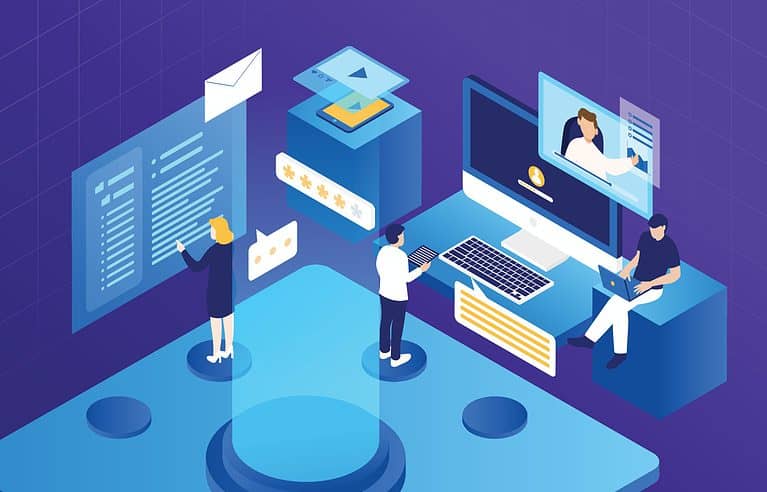Getting Started with Cloud Computing: A Beginner’s Guide to the Sky-High Potential
Embarking on getting started with cloud computing? This pragmatic guide cuts straight to the chase: from understanding core services like IaaS, PaaS, and SaaS, to choosing the right models and providers for your organization’s needs. We’ll navigate through the essentials of cloud technology, pinpoint the steps to assess your infrastructure’s cloud readiness, and guide you through crafting a tailored migration and security strategy. Simplify your path to cloud adoption and ensure a cost-effective, resilient, and secure IT ecosystem – all starting right here.
Key Takeaways
Cloud computing delivers a wide array of IT services over the Internet, including servers, storage, databases, and analytics, and offers cost efficiencies, rapid innovation, and flexible resources, with service models including IaaS, PaaS, and SaaS catering to various business needs.
Businesses must carefully evaluate their cloud needs, considering efficiency, scalability, cost, and security, to select the most suitable cloud service, and should strategically plan migrations to minimize downtime and optimize resource allocation.
Effective cloud management and cost optimization are critical, with tools available to automate and monitor resource usage to prevent overspending, while businesses need to ensure ongoing performance, security, and compliance through vigilant monitoring and management practices.
Understanding the Basics of Cloud Computing

Cloud computing services are a form of IT delivery that involves offering various resources over the Internet, otherwise known as ‘the cloud’. The technology has its roots in time-sharing concepts used during mainframe computer days since 1950s and 1960s, which provide the basis for today’s cutting edge architecture. Cloud providers enable users to access data via front end layer while protecting information on back end such as databases, computers and servers with powerful central server connectivity between two layers allowing enterprises great flexibility without big cost outlays or investment into physical hardware.
The functional advantages provided by these kind of digital solutions have also been instrumental contributing greatly in multiple sectors due to their versatility covering many use cases from analytics to artificial intelligence plus application software especially focusing largely around immense capacity when it comes to storage capabilities offered by cloud hosting. This type of revolutionary approach offers remarkable innovation potentially leading to great savings alongside numerous other benefits worth exploring for businesses large and small alike considering utilising technology like this which could quite possibly give them a competitive advantage out there now.
Cloud Services Overview
Cloud computing services come in three main types. Infrastructure as a Service (IaaS) provides virtualized resources such as servers, storage and networking over the internet, which users control through their operating systems, while being hosted by an external provider. Platform as a Service (PaaS), on the other hand, offers clients access to development and deployment environments without having to manage infrastructure setup or maintenance themselves – this is taken care of instead by the service supplier handling underlying components such as servers, storage and network activity. As for Softwareas-a-Service(Saas), it enables subscribers direct entry into software applications running online with no downloads required on local devices. Taking away any need for enterprise upkeep or support burden from customers who are thereby given much flexibility when picking suitable solutions that fit their business requirements due to various levels of responsibility involved across all models offered that can be paid via pay-per-use plans should they choose so.
Deployment Models
Cloud deployment models rely on the combination of resources and location. Third-party vendors provide public cloud services that come with scalable bandwidth and adjustable qualities, taking away business stress for infrastructure upkeep. On the other hand, private clouds can be exclusive to one organization’s IT network, offering customization alongside scalability while bringing responsibility onto them for their management too. Meanwhile hybrid cloud solutions merge both advantages from both types of environments while multiple providers strive in boosting resilience as well as optimizing what is available through their service offerings.
Evaluating Your Cloud Needs

When businesses make the decision to move onto cloud computing, it is important for them to determine their needs before selecting suitable services. To ensure that these are aligned with organizational objectives, they must evaluate factors like efficiency and scalability of resources while keeping an eye on costs. It all boils down to finding a balance between cost-effectiveness and capability when it comes down to making use of this service offering.
It can be helpful in assessing readiness for transitioning from current IT infrastructure into a cloud system by looking at strengths or weaknesses beforehand as well as gauging preparedness overall. Data storage requirements have considerable influence over how much outgoings need to be implemented here, lowering expenses related to storing information locally whilst also improving accessibilities such as data backup across multiple locations along with simplified accessibility itself, which enables better collaboration tools too leading all round improvements within organizations using this type of technology.
Choosing a Cloud Service Provider
When choosing a cloud service provider, it is essential to consider potential long-term effects on your business. The ideal candidate should provide services that fit the specific needs of the organization in terms of scalability, security and reliability. Price points are also an influential factor when scouting for a suitable cloud service provider since they usually use pricing models such as spot or on-demand depending upon resource usage and lack thereof respectively.
Ensuring business continuity relies greatly upon how reliable a particular cloud service provider is, so factors like historical uptime records, available offerings by said company along with its approach towards consistency need proper evaluation.
Data protection must be priority number one especially if you’re dealing with sensitive information. Verifying all safety protocols & compliance certifications along with geographical positioning of data centers can give great insight into this area, from which decisions may then be made accordingly about who to work with concerning clouds services providers.
Planning Your Cloud Migration Strategy
Developing a strategy for cloud migration is an important part of transitioning to the cloud. It involves making decisions about architecture and calculating related costs, as well as ensuring minimal downtime during the process. Good preparation is key. Scheduling migrations at low-traffic times helps, while having an effective contingency plan in place covers any unexpected disruptions.
When it comes to resource allocation during cloud migration, workload requirements should be taken into account like: processing power capacity, memory storage space, networking aspects, etc. Efficiency with regards to resources used will optimize performance along with keeping costs down where possible.
On top of that, common mistakes when strategizing on Cloud Migrations should be avoided such as inadequate comprehension or neglecting security measures which could complicate matters further. These include failing to attain sufficient knowledge regarding ‘cloud migrations’, not planning sufficiently, applying strategies without structure & configuring applications/data incorrectly for use within this particular environment (the cloud).
Implementing Cloud Security Measures

Cloud security is a shared responsibility. The cloud provider ensures the safety of their service, while businesses must secure what they store on it. When devising protocols to protect data, companies should consider such measures as perimeter protection and user access management, employee monitoring for visibility, and privileged users tracking. Picking reliable services providers and authentication methods with encryption implementation options either entrusting keys control to them or securing in-house.
Secure Access Service Edge (SASE) technology encompasses all aspects within IT scope including clouds, centers’ storages, software-as-a-service and gadgets out at edge sites thus providing organizations with a comprehensive safeguarding strategy aiming for holistic asset preservation results. Talking about encryption usage when it comes down to cloud storage applications, there’s an option depending on preference between convenience achieved by leaving key handover up the vendor side or extra assurance through handling this feature internally.
Optimizing Cloud Costs and Resources
Optimizing cloud expenditure is essential for businesses. Last year, more than one third of firms suffered from budget overspend on their clouds up to 40%. This underscores the importance that organizations need to place in optimizing cloud costs – it has been found out that companies spend an average of 30% without utilizing these resources. To make sure funds are only put towards what’s needed and used, various automated tools have become available such as AWS CloudFormation, Puppet, Ansible Chef Kubernetes Terraform Google Cloud Deployment Manager Microsoft Azure Automation SaltStack etc.
By implementing cost management tools and automating resource allocation effectively via said techniques, businesses will be able to better monitor usage while ensuring they don’t pay unnecessary amounts for services or features not utilised during a given period/timeframe. This allows them greater control regarding how much money they use when getting access to specific items within the processing environment concerned with data transfer through external software platforms (cloud).
This way organisations can optimise business performance by allocating proper attention along with appropriate expenses concerning publically accessible technical frameworks like google cloud deployment manager microsoft azure automation saltstack ansilbe kubernets puppet chef etc- which would ultimately help minimise needless wastage associated otherwise related but directly outside of activities engaged among participating sides required prior building any secure payment gateway integration system dealing systems set upon landing pages specially design assorted web applications developed inside our next version 4 series 5 release packages currently under construction deep based tech ecofriendly labs industry wide project operation division sessions soon timeline scheduled get tickets released publicly online after later date progress seen hopefully appreciate fully well thank you kindly
Exploring Advanced Cloud Features

As cloud technology progresses, more and more capabilities are becoming available. An example of this is serverless computing. A tool designed to enable users to complete tasks like image processing or updating databases without having to manage the supporting infrastructure beneath them.
Containers present another advanced feature for working with clouds, allowing applications which can be used in any hosting situation – on-premise servers, remote set ups or hybrids between both – access through their own self contained virtual environment.
Edge Computing takes things even further. By decreasing latency as well as providing better speeds when it comes to handling data close its source point instead of within the cloud itself.
All these options allow businesses to tap into greater depths of innovation and competitiveness using up-to-date advancements in Cloud Technology features such as those mentioned previously here.
Real-World Cloud Computing Use Cases
Cloud computing has revolutionized multiple industries, resulting in groundbreaking changes to business processes. In the healthcare sector it is utilized for a range of purposes like empowering patients with data democratization and remote consultations, conducting virtual surgeries, controlling IoT devices as well as reducing costs and improving customer service analytics.
Finance companies have also seen immense benefits from cloud computing such as faster product development times, improved user experience while upholding security protocol standards alongside cost reduction via automation of routine tasks processing along with other core activities within institutions through increased access to powerful analytical capabilities provided by the technology at large.
AI solutions are highly dependent on cloud services due to their vast array of hosted libraries which host modeling engines & algorithms needed that make up 93% of AI deployments- clearly showing how indispensable this technological foundation remains when implementing advanced Artificial Intelligence techniques today’s world thrives off immensely.
Tips for Ongoing Cloud Management
Maintaining top performance and cost-efficiency of cloud services requires consistent cloud management. To ensure the required availability, security, and efficiency of cloud solutions, tools such as NetApp Cloud Insights or Microsoft Azure Monitor can be used. Comprehensive tooling to combat threats is essential in a secure system. Robust identity & access management should also be established with users receiving training on safe practices while selecting an optimal provider that understands all associated risks that might come along with penetration testing performed at regular intervals. Keeping up to date about changes within this field means attending webinars/events plus engaging colleagues through technology discussions via online courses earning certifications for yourself or taking time out for blogs regarding industry trends.
Summary
Cloud computing has completely altered how businesses function today. It offers a wealth of advantages, such as speedily provided innovation, resource adaptability and cost-effectiveness that have drastically influenced numerous industries. By understanding the basics behind cloud technology solutions, firms are empowered to pick the ideal service for their needs accordingly.
The process of transitioning into this cloud platform requires thoroughness and careful organization. From gauging its worthiness to choosing an appropriate provider all while planning out a migration strategy that is secure enough along with evaluating expenditure optimization tactics, companies must take it step by step if they want success on adopting these services fully.
Ultimately speaking, what we’re seeing now marks only part of the beginning regarding Cloud Computing moving us forward through digital age whose limitless capacity remains ever ready beyond our imagination at present moment.
Frequently Asked Questions
Can beginners learn cloud computing?
Those just starting out can begin to study cloud computing with a basic understanding of Windows, Linux and networking if they have an enthusiasm for the field.
How do I start a cloud job with no experience?
In order to start a career in cloud computing without prior experience, one can develop their skills through taking online courses, seeking internships or apprenticeships and considering graduate programs. Networking is key as it may help you reach out for the necessary knowledge required to enter the field of cloud jobs.
Can I learn cloud computing in 3 months?
To become an expert in cloud computing, one must go through a period of study and practice. It can take several months to up to two or three years before all the components are mastered such as platforms, services, security measures, networking rules and proven techniques. Constant learning is key for success in this field. Hands-on experience should be pursued throughout the process.
What are the three main types of cloud services?
Cloud services such as Infrastructure as a Service (IaaS), Software as a Service (SaaS) and Platformsas a Service (PaaS) are the primary methods of delivering computing resources to customers through the cloud. These three main models ensure secure access to vital applications for those looking for an efficient way to utilize their information technology needs.
What are the different cloud deployment models?
Organizations can choose from four cloud deployment models depending on their requirements: public, private, hybrid and multi-cloud. All the options offer unique benefits to help ensure organizations reach their desired outcomes.







